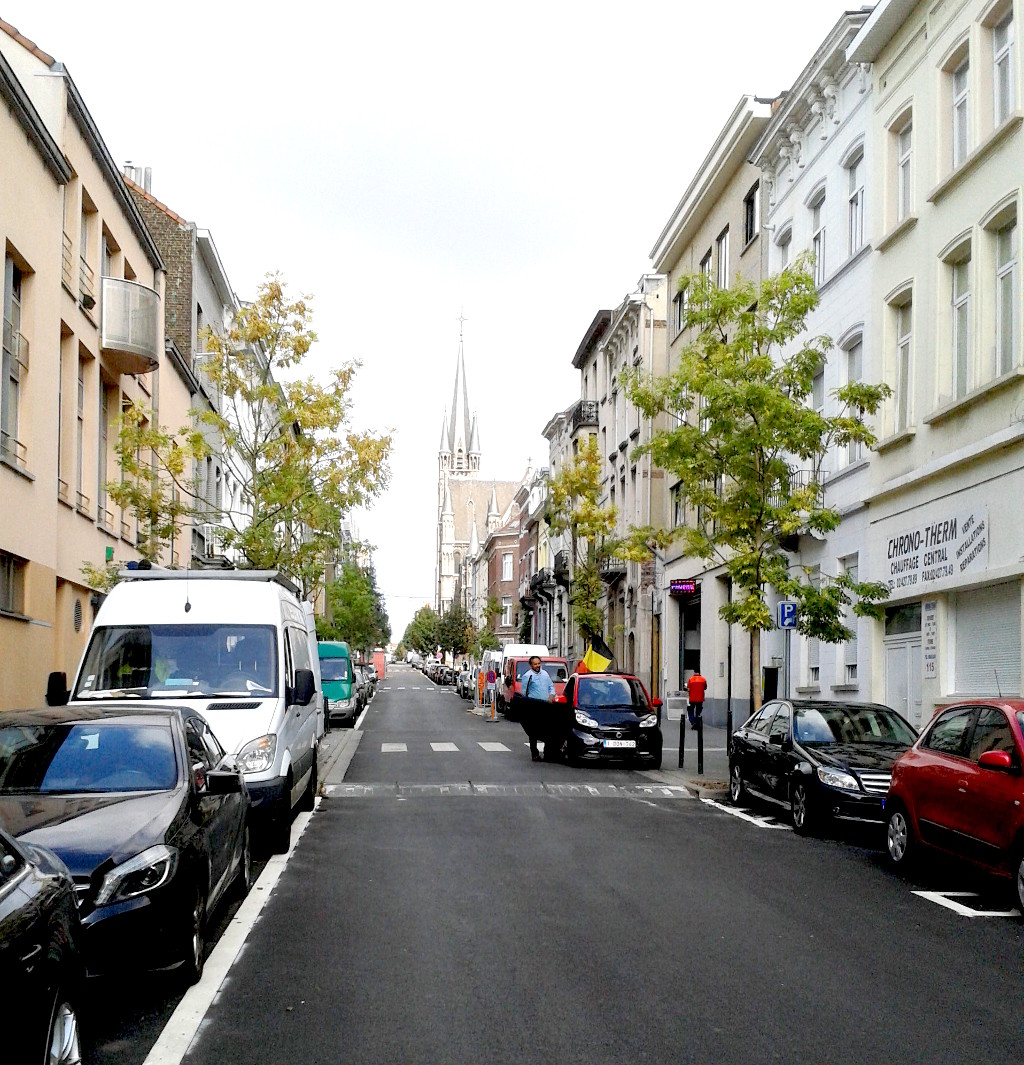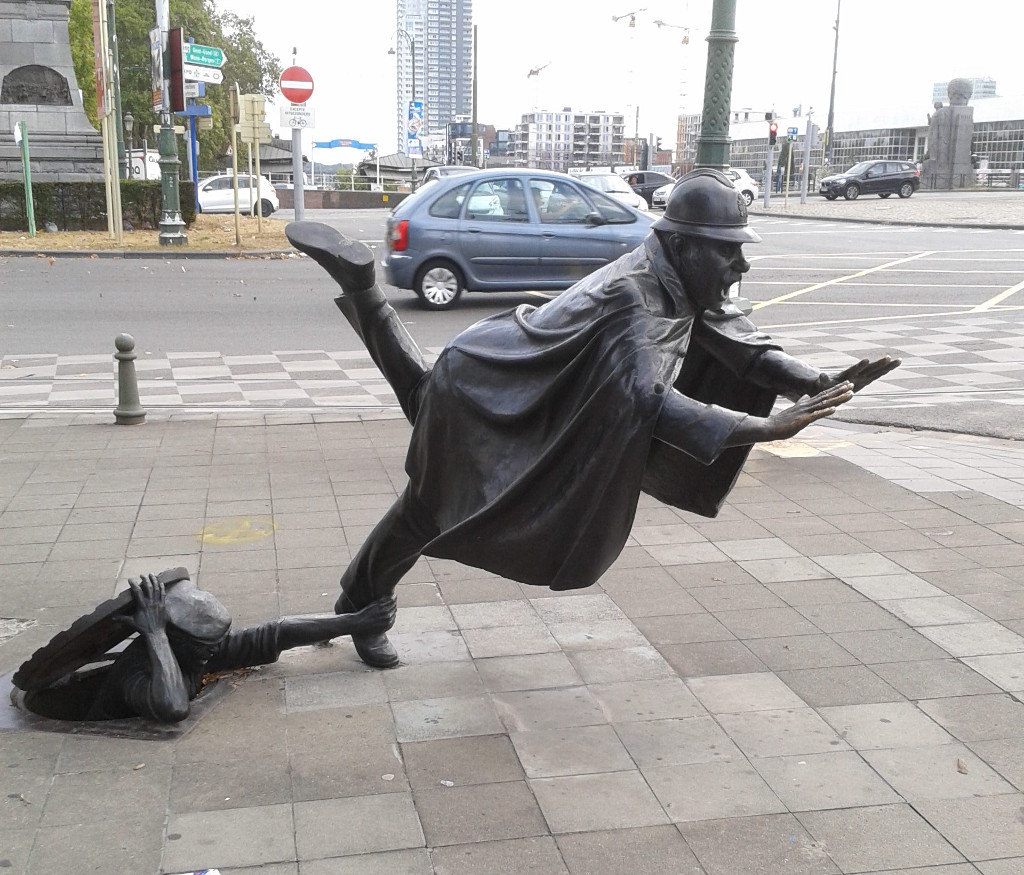This is the first day of a five day intensive for play-fighting with teacher Bruno Caverna on Monday 6 August 2018. [Next day]
Hybrid Studios in Brussels isn’t the easiest venue to find. But I join the opening circle before it ends, introducing myself and saying my background is in dancing contact improvisation.

To start, we walk in the studio space weaving in and out of each other or simply following our own walk. Then we walk with our hands on the shoulders of another person, move away, find another and do the same. Bruno adds some music and the pace quickens to the end of the introduction.
Resistance and Non-resistance
Now the practice of non-resistance is introduced: this is the core of the course.
Partner work: put your hands on your partner including with a light grip and move with them – fall with them – to the ground but stay on your feet. They must release tension and not hold their standing posture – give-in to gravity so that they are falling and lay on the ground in some way, off their feet. Notice how you feel as you fall- fear is a common response says Bruno. Breathe out as you fall, and to start the fall in your partner this way too. Go with them to initiate it.
I notice that the head is almost always last to the ground; the feet anchor us to the ground especially the person who leads the falling and remains on their feet; that – due to tethering or bridging from the falling to their partner (the standing person) then they will stay with you and not fall away from you or simply fall over. Principally we are folding – at the waist or the knees – to fall. We maintain our integrity in falling. Why would we not fall? While Bruno calls this non-resistance technique, it’s more widely known as release technique.
I find that have a tenancy to spiral in falling which I might need to inhibit for the play-fight practice? It is my habit. In an exercise with Bruno, I release internal tension and start to spiral. “No just step” he says.
Now we combine the two elements – moving across space with a partner; and falling with them – or going to ground. We should not resist our internal resistance to falling by trying to overcome it. Bruno talks of intention – we must give up our intention too. In the feedback session, the idea of non-doing is presented- that non-doing is doing – an idea I’ve encountered elsewhere.
‘ … sometimes you find a tiny door,
and if you open it then behind it
there is a vast ocean.’
Bruno Caverna
Trip this way

After lunch then we study the movement of the foot in walking on the floor – which part strikes the floor first, and what is the transfer of weight to it. Initially, we simply walk with a partner – side by side, noting how our foot steps create a melody. We can also contra step too – or cross step, as tango dancers say. There is a critical moment when we commit to placing a foot on the ground and giving our weight to the floor.
Now we study tripping-up our partner. Initially, we follow them on our hands and knees – they walk and we crawl beside them. We must knock the foot – push it away from us – just at the moment of weight transfer to the floor. Next we repeat the exercise but walking beside our partner and using our foot to pull away our partner’s foot at the moment of weight transfer. It’s a little trip which leads to falling.
We add another element to the tripping exercise. We can block our partner by standing in their path causing them to turn and avoid us. For our next addition, we walk with our partner and step on their foot – pinning it down – another way to induce falling in them. Finally, we add something else into the mix: lengthening their stride by pulling or pushing their foot out as it moves down on the out-step thus tripping and falling. We can use our hands for this or use a foot to hook our partners foot and lengthen their stide. It requires careful timing and it’s not easy.
Another exercise: We can put our hands out and our partner takes our hands or arm at the elbow and we walk together: it’s a practice embrace as we say in tango but then we trip them. It’s ‘spicy tango’ says Bruno. We dance to music (‘jam’) in the way which we have learnt so far.
Bruno demonstrates with Ester who works at Formless Arts with him and who assists him in the Play-Fight course. He throws a pretend punch with both hands to one side which she catches and then falls with. Next – throw a ball he says to her and she mimics the actions of ball throwing. He reacts similarly to her reaction to the pretend punch – releasing and falling.
In the feedback at the end, we review the movements in this play-fight. Bruno adds that there are accusations of gender bias in play-fighting with men dominating which I interpret to mean men leading and women following in the playfight dance. There are 23 people attending this Intensive with 17 women and 6 men. I find this surprising – why are there fewer men here? Perhaps it is seen as dancing – where women typically outnumber men – or maybe many men want ‘real’ fighting – martial arts or similar – and so avoid play-fighting? I notice how some of the women with whom I dance tend to avoid leading though. In subsequent days, I will offer to follow and say about gender roles, etc.
The background of the attendees includes contemporary dance, contact improvisation, self-defence, yoga and Capoeira. The latter is a non-contact dance which has a fighting form. Clearly, it is ‘dance’ where this practice of ‘play-fighting’ is situated – at least for this course. The subsequent use of dance vocabularly with reference to the movement practice on this course, also leads to this conclusion.
See the next day of the Play-fight Intensive (day 2)
See the last day of the Play-fight Intensive (day 5)
Notes
Featured/Top image: The door to Hybrid Studios in Brussels. Hybrid Studios – rue de l’Intendant 111 – 1080 Brussels, Belgium.
